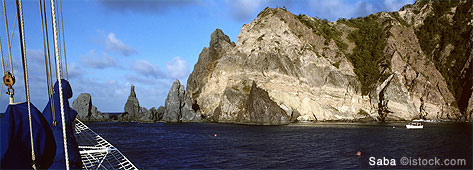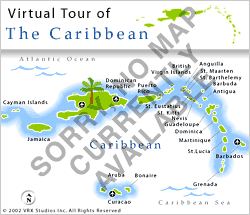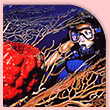
Saba | Hotels
Just a short ferry ride from Dutch St Maarten is another Dutch treat called Saba. This island cone of an extinct volcano is lush, green and hilly with outrageous undersea coral gardens and picture-postcard hamlets and villages. Saba is a special high for nature lovers. There is only one road, appropriately called The Road. So you can't get lost on this five-square-mile isle once owned by France, Spain and Great Britain but now an overseas part of The Netherlands.Saba - Destination guide 

Caribbean Information Centre
Caribbean.com is a travel site specializing in The Bahamas, Bermuda and the Caribbean region. Our destination guides contain thousands of listings and virtual reality map tours to help you plan your perfect vacation. Listings include hotels, restaurants, activities, attractions, diving, snorkelling and shopping for 50+ destinations.Saba feature 
CARIBBEAN.COM 2004 - COURTESY DUPUCH PUBLICATIONS

All about Saba
The smallest of the three Windward Islands that comprise the Netherlands Antilles is huge in charm, spectacular mountain climbing, scuba diving, hiking, outdoor living, and scenic views. For the latter, walk the 1,064 steps to the top of Mt Scenery. On a clear day, you can see St Martin/St Maarten, Sint Eustatius, St Kitts and Nevis.
Perhaps the most awesome of Saba's delights are its colourful villages of Hell's Gate, Windwardside, St John, and The Bottom. The latter takes its name from the Dutch word botte, meaning bowl. The Bottom is at the bottom of the extinct volcano that formed Saba - pronounced SAY-buh. Unlike most other Caribbean sandy isles, there is almost nothing to offer in the way of beaches. A small black-sand beach at Fort Bay disappears and reappears according to tidal notions. But, there's a magical fairyland of scenery below the sea. That's where the Saba Marine Park comes into the picture. The reserve surrounds the island and includes waters and a seabed up to 200 feet, or 61 metres, in depth. There are about 26 dive sites, as well as perfect venues for anchoring your yacht, going fishing, diving, or all three pleasures. Fort Bay also offers a hyperbaric facility, donated by the Royal Netherlands Navy.
Although Dutch is the official language, most everyone speaks English. Under Dutch jurisdiction, the islanders are blessed with the Dutch passion for education and an infrastructure that is as efficient as it is clean and simple.
The Bottom, with about 400 residents, is in a valley among several large hills. The Road, as the island's only road is called, passes through spectacular views to Windwardside, then on to The Bottom, and Fort Bay. In the latter two towns, you will find such amenities as a pub, gift shop, electricity plant, petrol station, dive options, cruise ships and yacht anchorage, car rental agencies, a bank, post office, affordable small inns and guesthouses. Saba villages are chockablock with snug Dutch-styled cottages with red-shingled roofs, white picket fences with green shutters, and loads of tropical flowers and trees. Each village has access to a hospital, school and the like. There is Zen-like peace, and homes at the tops of hills are cooled by sea breezes acting as natural air-conditioning.
Best shopping is in Windwardside. A sign on one of the shops tells all you need to know, namely: Gifts, Oddments, and Pretties. The most typical of gifts are Saban lace, called "Spanish work" because the art was imported from Venezuela. Saba is also famous for its potent Saba spice. It is spiced with all kinds of spicy products and then spiked with 151-proof rum.
Among island celebrations are the December Saba Days, featuring parties, dances, and donkey races. Before the "horseless carriage," after all, donkeys were a favourite form of transportation in the Antilles. A Saba Summer Festival is the island's answer to Carnival with calypso contests, talent shows, and a parade. Like all other islands in the Dutch Antilles, one of the biggest holidays is reserved for the Dutch Queen's Birthday, April 30. Saba, after all, is one of five islands governed as the Netherlands Antilles, with its headquarters in Willemstad, Curacao. The other islands are Sint Eustatius, St Maarten, Bonaire, and Curacao. In 1986, the prosperous former Dutch colony of Aruba was granted status as an entity unto itself within the Kingdom of the Netherlands.
Saba - Items of interest 
Accommodations
Dining & entertainment
Activities, attractions, diving, golf and sports
OTHER LINKS AND INTERESTS

Sign up, its free!
Get deals & specials for
Caribbean Vacations
CLICK HERE
*we do not release contact information
CARIBBEAN.COM VACATION SPECIALS
Click here for vacation specials from our partners: Hilton, Westin, Sheraton, Marriott and more





